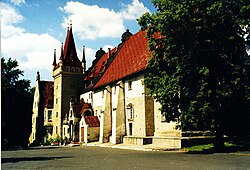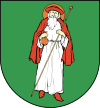Sobotka
| Sobótka | ||
|---|---|---|

Castle
|
||
|
||
| Coordinates: 50°53′55″N 16°44′40″E / 50.89861°N 16.74444°E | ||
| Country |
|
|
| Voivodeship | Lower Silesian | |
| County | Wrocław | |
| Gmina | Sobótka | |
| First settled | 2nd century BC | |
| City Rights | 1399 / 1221 | |
| Area | ||
| • Total | 32.20 km2 (12.43 sq mi) | |
| Highest elevation | 718 m (2,356 ft) | |
| Lowest elevation | 150 m (490 ft) | |
| Population (2006) | ||
| • Total | 6,832 | |
| • Density | 210/km2 (550/sq mi) | |
| Postal code | 55-050 | |
| Website | http://www.sobotka.pl | |
Sobótka [sɔˈbutka] is a town in Wrocław County, Lower Silesian Voivodeship, in south-western Poland. It is the seat of the administrative district (gmina) called Gmina Sobótka. Sobótka is located about 30 km (19 mi) southwest of Wrocław on the northern slope of Mount Ślęża, part of the Central Sudetes mountain range. As of 2006[update], the town has a population of 6,832.
The area had been settled since prehistoric times, as evinced by numerous archaeological artefacts, and in the 2nd century BC Mount Ślęża was the site of a sanctuary of the Celtic Boii, marking a northern outpost of their settlement area.
In 1128, the Polish voivode Piotr Włostowic established an Augustinian monastery on Mount Ślęża which was later moved to Wrocław, while the area remained a property of the Augustinian order. The settlement was first mentioned in an 1148 bull issued by Pope Eugene III as Sabath, from Latin: sabbatum, Polish: Sobota, "Saturday", referring to a weekly market. The market rights were confirmed by the Silesian duke Bolesław I the Tall in 1193. His son Duke Henry I the Bearded granted it town privileges rights according to Magdeburg Law in 1221. The location of the city is on the ancient Amber Road and its first role was trade. After the Polish King Casimir III the Great had renounced Silesia, Sobótka in 1353, due to marriage of the Czech princess, became the Bohemian kings territory. King Wenceslaus explicitly acknowledged the city rights in 1399. The town was again purchased by the Augustinians in 1494.
...
Wikipedia


